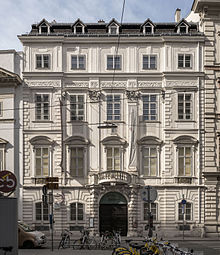Mollard-Clary Palace
The Palais Mollard (-Clary) is a baroque city palace in the first Viennese district of Inner City , Herrengasse 9th
history
Around 1250, Seifried von Mödling erected the first building in the area of today's numbers 9-11 in the newly created settlement area on Hochstrasse (from the 16th century "Herrengasse"). His courtyard bordered the cemetery of the Minoriten , who had their settlement on Minoritenplatz as early as 1224.
In the fire disasters of 1326/27, which cremated two thirds of all Viennese houses, the house on the Herrengasse 9 plot, which at that time belonged to the widow Gertrude Magenpuech, was also destroyed. It was rebuilt and came into the possession of Friedrich II. Von Stubenberg , as well as the adjacent houses in the Herrengasse 11 area.
In 1440 the noble Hans Pruckner, a member of the lower nobility, acquired the house and donated it to the parish of St. Michael in his will . Pruckner was in the service of Duke Albrecht V , later of Emperor Friedrich III. His list of assets and inventory shows that there was a large, vaulted room, several living rooms and bedrooms, an elongated room and small rooms and basement rooms.
In the fire disaster in 1525 , more than 400 houses near the Hofburg were destroyed, including the parish church of St. Michael. It can be assumed that the building at Herrengasse 9 was also affected and was at least partially destroyed.
On the first plan of the city of Vienna by Bonifaz Wohlmut (1547) the parcel at Herrengasse 9 is already drawn in its present form.
Property of the Mollard (1563-1760)
In 1563 , Peter von Mollard , who came from an aristocratic Savoy family, bought the Freihaus in Hochstrasse from the parish of St. Michael , who had previously owned it as a foundation house. The corresponding sales letter between Valentin Sixtl, chaplain and pastor of St. Michael, and Peter von Mollard is dated July 6, 1563. Peter von Mollard died in 1576, his five sons inherited the house in 1591 after their mother's death. The eldest son, Ernst, became one of the closest confidants at the court of Emperor Rudolf II in Prague, while his brother Hans served with the Archduke and later Emperor Matthias , and he became President of the Vienna City Guard . Big politics were made in the house at Herrengasse 9.
1609 is the first view of the house Herrngasse 9 is on the bird's-eye view of the Jacob Hufnagel handed.
In 1695, Ferdinand Ernst von Mollard , Vice President of the Court Chamber and father of Karoline von Fuchs-Mollard , commissioned the Italian architect Domenico Martinelli with a baroque renovation and expansion of the house. A fourth floor was added to the house, the three-storey transverse wing in the courtyard, including a chapel and a large staircase, were built. The narrow connecting passage in the Piano Nobile was decorated with mythological oil paintings that are attributed to Andrea Lanzani .
In 1733 numerous construction defects have been handed down, including the badly dilapidated roof having to be replaced. The repair work was carried out by Lucas von Hildebrandt .
Owned by the Clary (1760–1922)
In 1760 the palace was acquired by Count Franz Wenzel von Clary and Aldringen as a winter residence for his noble family, who lived in Teplitz Castle in Northern Bohemia. It remained in their possession until 1922.
Around 1780, the society of high Viennese aristocrats, known as the “Round Table of Josef II”, met regularly in the Palais Clary. In 1810 Prince Carl Clary set up one of the most important private libraries in Vienna and a collection of copperplate engravings and drawings on the second floor. Parts of the original furnishings were later found in the Clary family's depots in Teplitz Castle .
In 1879/81 the house was completely renovated. Heating and sanitary facilities were installed, and the facade was renovated and redesigned. In the course of the 19th century the family moved to one floor and rented the rest of the palace first as a British embassy , then as the royal Bavarian embassy. In 1922 the palace was sold to the state of Lower Austria , which set up the Lower Austrian State Museum here. On September 10, 1944, the rear part of the house was badly damaged by a bomb.
Todays use
After extensive construction work, the museum was reopened in December 1951.
1986-88 extensive underground construction work (U3) was carried out directly under the palace . The federal government acquired Palais Mollard from the state of Lower Austria in 1999, and the Lower Austrian State Museum found its new location in the state capital St. Pölten. In 2002, for the next three years, the building for the Austrian National Library was converted and completely refurbished according to plans by architect Gerhard Lindner.
The palace is used by the Austrian National Library and has housed the Esperanto Museum and Collection for Planned Languages ( ground floor), Globe Museum (1st floor), Beletage | Event rooms (2nd floor) and the music collection (3rd – 5th floor) of the Austrian National Library.
literature
- Hellmut Lorenz , Wilhelm G. Rizzi: On the planning and construction history of the Palais Mollard-Clary in Vienna . In: Wiener Jahrbuch für Kunstgeschichte 38, 1985, ISSN 0083-9981 , pp. 239–246
Web links
- Music collection of the Austrian National Library
- Esperanto museum and collection for planned languages
- Globe Museum
- Planet Vienna | Mollard-Clary Palace
- Entry via Palais Clary on Burgen-Austria
Coordinates: 48 ° 12 ′ 33.5 ″ N , 16 ° 21 ′ 55 ″ E

